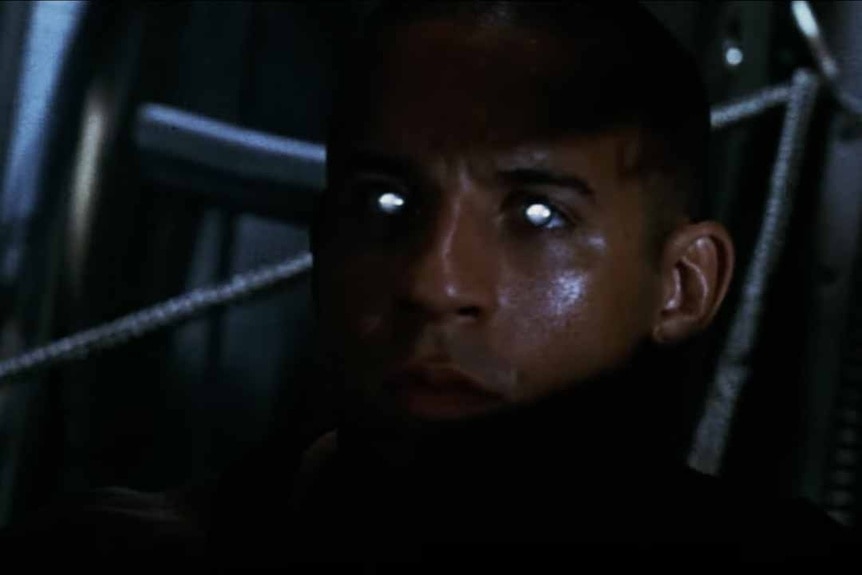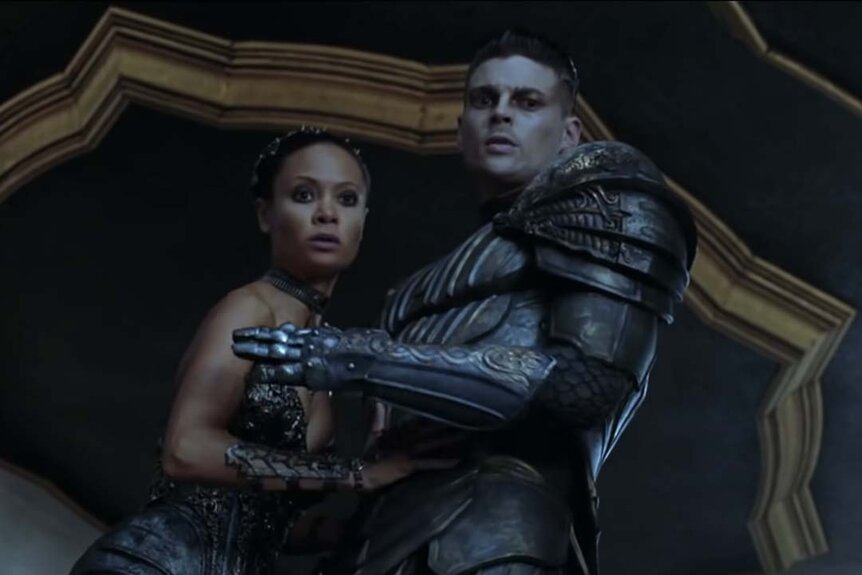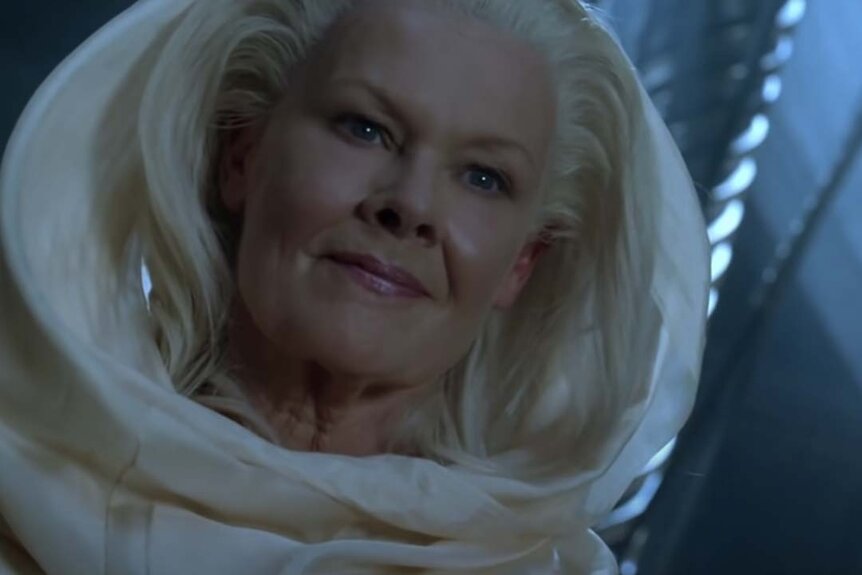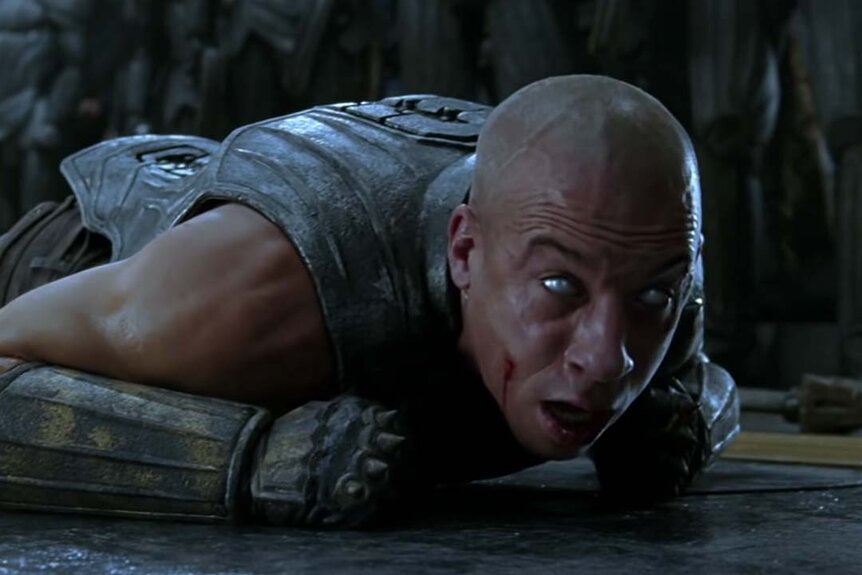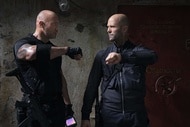Create a free profile to get unlimited access to exclusive videos, sweepstakes, and more!
Making Sense of Vin Diesel's Sci-Fi Epic: The Riddick Timeline Explained
Tracking the travels of Vin Diesel’s iconic space savage.
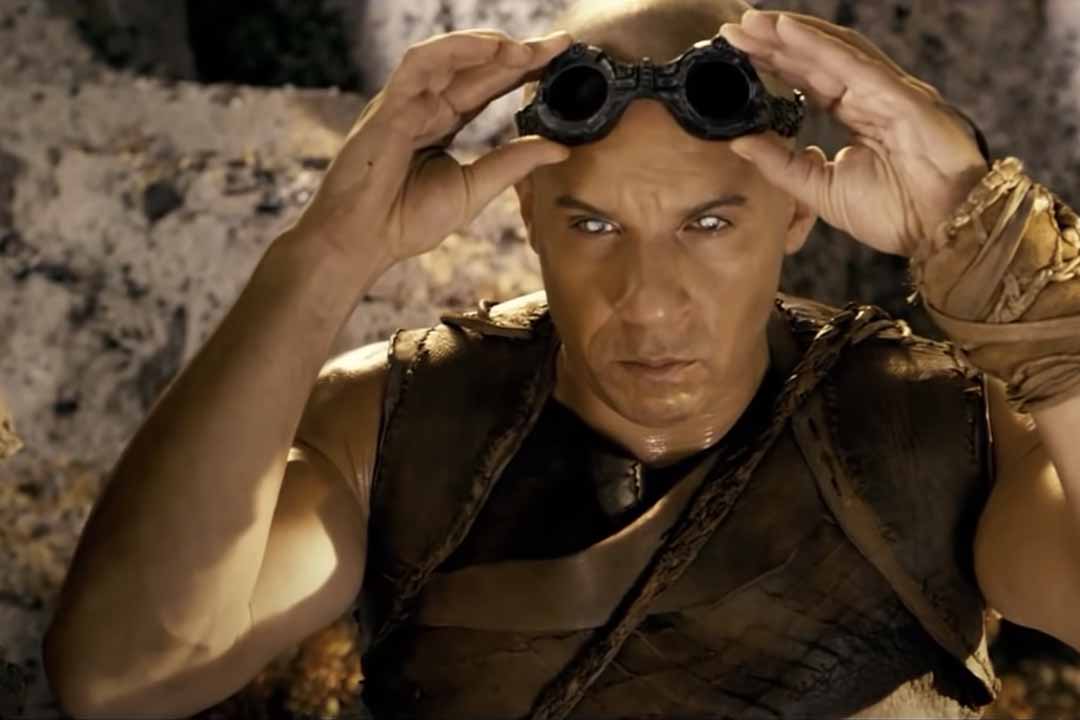
For a space fugitive who’s had three whole movies (not to mention a handful of video games and other canonical media) devoted to his exploits, Richard B. Riddick remains a pretty mysterious guy. Even the stuff we think we know about star Vin Diesel’s stoic space anti-hero has been revealed in tantalizing half-measures (how did he really get those night-sight "shine" eyes?), or else left mostly to our imaginations (will we ever get to see his fabled home planet of Furya?)
But in spite of all that, Diesel and partnering film director David Twohy have built a still-expanding sci-fi franchise that’s left us with a pretty solid timeline for where Riddick comes from… as well as where he might be headed next. With development apparently ramping up for the upcoming fourth Riddick film (known so far as Riddick: Furya), let’s see what we can piece together about Richard B. Riddick’s renegade past by taking a closer look at the larger franchise’s timeline.
Riddick’s origins: A Furyan with a tragic past
We know from all three Riddick movies (streaming here on Peacock, beginning with Pitch Black) that Riddick is a Furyan, one of the last surviving members of a fierce race of human-adjacent warriors whose homeworld — often talked about in the films but so far unseen onscreen — was decimated by the technocratic religious empire known as the Necromongers. Evangelical in the extreme, the Necromongers were introduced in the second movie (2004’s The Chronicles of Riddick) as a near-omnipotent military cult whose members all come from forced conversions, uniting via an almost hive-mind type of induction into the Necromonger culture that’s done by culling the populations of the many planets the empire has visited and conquered.
RELATED: The Riddick films show Vin Diesel's rise to peak Diesel-ness
Why are we talking about Necromongers already? Because they play a key role in shaping Riddick’s earliest years of life. In the first Riddick movie (2000’s Pitch Black), Riddick offers a glib and quick explanation of how he was apparently cast aside and unwanted as an infant. In Pitch Black, Riddick briefly regales a fellow crash survivor (the “Holy Man” Imam played by Keith David) on what it’s like to “start out in some liquor store trash bin with an umbilical cord wrapped around [your] neck.” The second film builds on that reference, explaining that Zhylaw, the Lord Marshal of the Necromongers (essentially their spiritually enlightened military leader played by Colm Feore), received a prophecy 30 years earlier that foretold of a Furyan who would someday rise up and kill him.
Zhylaw’s response to this prophesied threat was pretty Biblical in nature: He ordered the Necromongers to invade the Furyan homeworld and commit wholesale murder of every newborn Furyan male, many of whom were strangled at birth by their own umbilical cords. Riddick was among the infants targeted in the slaughter, but he (obviously) survived, leaving him to mature as one of the only known adult Furyans in the universe.
Intriguingly, The Chronicles of Riddick does introduce us to one other Furyan survivor, a Necromonger priest (known as the “Purifier”) played by Linus Roache. But his role only serves to reinforce the idea that maybe Riddick really is fated to fulfill that original prophecy. After letting Riddick escape a fiery sunrise on the prison-planet outpost of Crematoria, the Purifier invites Riddick to fulfill his destiny and kill the Lord Marshal… before walking out into the searing sunrise and being immolated in its 700-degree heat, an extraordinary Necromonger self-sacrifice that leaves Riddick free to carry out the prophecy.
RELATED: Can You Really "Shine" Your Eyes? The Science Behind Pitch Black and Night Vision
For his part, Riddick does assure that the priest’s death wasn’t all in vain. He travels back to the Necromonger fleet (who’s smack in the middle of a forced-conversion exercise on the peaceful planet of Helion Prime) and slays the Lord Marshal. Though bittersweet (Riddick loses his longtime friend Jack, aka “Kyra,” in the struggle), it’s an epic victory in more ways than one. Not only does it deprive the upstart Necromonger usurper Vaako (played by Karl Urban) of his own shot at the Lord Marshal’s title, it also compels the entire Necromonger empire — per their own warlike tradition — to recognize Riddick as their new Lord Marshal.
Wait, isn’t Riddick just a murderous convict?
If it weren’t for the sweeping prophetic events in The Chronicles of Riddick, fans might be inclined to view Diesel’s badass portrayal of the character across the franchise through a completely different lens. After all, he’s introduced in the first film (Pitch Black) as little more than a resourceful convict who’s lucky enough to escape custody when his transport ship crashes.
Sure, he ends up befriending a small handful of fellow crash victims along the way — the Imam, the ship’s captain Fry (Radha Mitchell), and “Jack” (played in the first film by Rhiana Griffith and in the second film, as “Kyra,” by Alexa Davalos). But just as his prophetic origins suggest, Riddick’s really a lone-wolf operator — which is exactly where we find him at the start of Riddick, the 2013 third franchise film that begins not long after his tumultuous ascent to Necromonger leadership at the end of The Chronicles of Riddick.
Though not much time has passed between those two movies, a lot has changed in Riddick’s world. At the start of Riddick, he’s once again alone on a hostile planet, injured from a fall and scrapping to survive as ferocious beasts close in. In a flashback memory, we learn why: Vaako couldn’t stand living under Riddick’s rule as a Necromonger (and Riddick himself found his whole “civilized” role as their new Lord Marshal a bit too much of a style-cramping burden anyway.) So Vaako teases Riddick with the promise of safe passage to his home planet of Furya, whose location has long been purged from history’s records. “The only map left in existence,” Vaako tantalizes, “is the one that’s in my head.”
Finding Furya: ‘Home has a certain equity’
“You can’t blame Vaako for dangling Furya. ‘Home’ has a certain equity,” Riddick, now stranded, ruefully reflects of Vaako’s treacherous offer. On the surface, it seemed like a win-win proposition for both Vaako and Riddick: Vaako could (presumably) ascend to fill Riddick’s vacant leadership seat among the Necromongers, while Riddick himself could finally reconnect with his ancestral home… even if it’s all but been destroyed.
But, of course, the whole thing’s a setup, as Riddick discovers when the Necromongers dump him on a strange “Not-Furya” planet (as he puts it) and blast the high ground he’s standing on into a deep chasm. Late in the Riddick franchise’s timeline, the double-cross leaves Riddick almost back at square one again — with no status among the Necromongers any longer, he only registers on the universe’s radar as a dangerous fugitive with a sky-high bounty price on his head.
That’s pretty much where Riddick started out in the first place in Pitch Black — only now, fans have a whole lot more backstory to explain why he keeps gravitating toward the solo way of life. Our night-sighted hero even manages to close one more long-winding story circle in Riddick, making frenemies in the third film with a bounty hunter (Col. R. “Boss” Johns, played by Matt Nable) who descends on the planet in search of tough answers about the death of his son. Who’s his son? Original Pitch Black villain William J. Johns (Cole Hauser), the cowardly snake of a bounty hunter from the very first movie who betrays his own crew (and even denies morphine to a dying man in pain, just so he can horde it to fuel his own closet drug habit).
Riddick and the elder Johns part as uneasy allies, after Riddick convinces the father that he isn't to blame for the younger Johns’ untimely Pitch Black demise. And while we’re talking timelines, it’s worth pointing out that Nable’s “Boss” Johns is one of the few surviving franchise characters who remain on the board for potential re-emergence in any future Riddick movies — a habit that the series, through three films and a motion comic (voiced by Diesel himself), among other media, has so far proven to favor.
In addition to “Boss” Johns, we also can presume that Urban’s Vaako character is still alive somewhere out there in the Riddick-verse, living it up as a Necromonger leader. And though we haven’t seen more from her since The Chronicles of Riddick, Vaako’s female companion Dame Vaako (Thandiwe Newton) was also still standing when we last saw her at the end of the second movie, scheming away to elevate her husband to the Lord Marshal’s seat. Also still living is the mysterious, wispy Aereon (played by Dame Judi Dench) — a shape-morphing member of the Elemental race who first prophesied of Riddick’s importance.
RELATED: How Vin Diesel Righted the Science Fiction Ship with Riddick
Other key recurring Riddick characters, though, probably aren’t so available for a potential sequel comeback. Jack/Kyra appears to have died during the feverish Necromonger fight at the end of The Chronicles of Riddick, while the Imam — a key figure in the first two movies — met his demise in the same film, as a victim of the Necromonger invasion on his home planet of Helion Prime.
It’s impossible to say, of course, whether any of the remaining Riddick characters might play a role in Riddick: Furya, the upcoming fourth film, since Twohy and Diesel have so far offered only upbeat (but vague) development updates on the movie’s progress. In the meantime, you can revisit the entire Richard B. Riddick franchise on Peacock in order by streaming Pitch Black (2000), The Chronicles of Riddick (2004), and Riddick (2013).
Originally published Dec 21, 2023.
